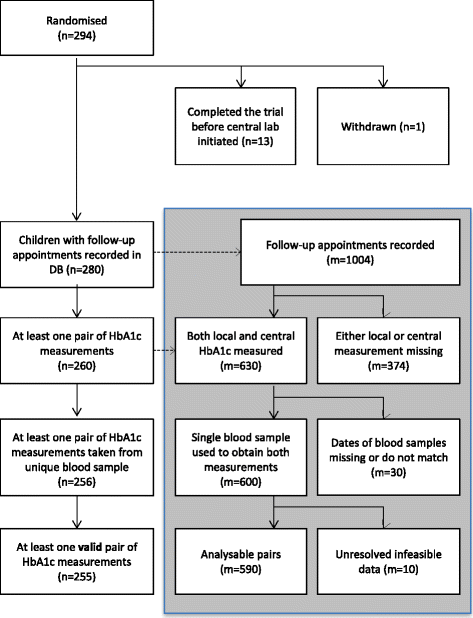Measurement of HbA1c in multicentre diabetes trials - should blood samples be tested locally or sent to a central laboratory: an agreement analysis
- PMID: 27776543
- PMCID: PMC5078896
- DOI: 10.1186/s13063-016-1640-6
Measurement of HbA1c in multicentre diabetes trials - should blood samples be tested locally or sent to a central laboratory: an agreement analysis
Erratum in
-
Erratum to: Measurement of HbA1c in multicentre diabetes trials - should blood samples be tested locally or sent to a central laboratory: an agreement analysis.Trials. 2017 Apr 5;18(1):164. doi: 10.1186/s13063-017-1914-7. Trials. 2017. PMID: 28381235 Free PMC article. No abstract available.
Abstract
Background: Glycated haemoglobin (HbA1c) is an important outcome measure in diabetes clinical trials. For multicentre designs, HbA1c can be measured locally at participating centres or by sending blood samples to a central laboratory. This study analyses the agreement between local and central measurements, using 1-year follow-up data collected in a multicentre randomised controlled trial (RCT) of newly diagnosed children with type I diabetes.
Methods: HbA1c measurements were routinely analysed both locally and centrally at baseline and then at 3, 6, 9 and 12 months and the data reported in mmol/mol. Agreement was assessed by calculating the bias and 95 % limits of agreement, using the Bland-Altman analysis method. A predetermined benchmark for clinically acceptable margin of error between measurements was subjectively set as ±10 % for HbA1c. The percentage of pairs of measurements that were classified as clinically acceptable was calculated. Descriptive statistics were used to examine the agreement within centres. Treatment group was not considered.
Results: Five hundred and ninety pairs of measurement, representing 255 children and 15 trial centres across four follow-up time points, were compared. There was no significant bias: local measurements were an average of 0.16 mmol/mol (SD = 4.5, 95 % CI -0.2 to 0.5) higher than central. The 95 % limits of agreement were -8.6 to 9.0 mmol/mol (local minus central). Eighty percent of local measurements were within ±10 % of corresponding central measurements. Some trial centres were more varied in the differences observed between local and central measurements: IQRs ranging from 3 to 9 mmol/mol; none indicated systematic bias.
Conclusions: Variation in agreement between HbA1c measurements was greater than had been expected although no overall bias was detected and standard deviations were similar. Discrepancies were present across all participating centres. These findings have implications for the comparison of standards of clinical care between centres, the design of future multicentre RCTs and existing quality assurance processes for HbA1c measurements. We recommend that centralised HbA1c measurement is preferable in the multicentre clinical trial setting.
Trial registration: Eudract No. 2010-023792-25 , registered on 4 November 2010.
Keywords: Agreement; HbA1c; Measurement; Trial design.
Figures
Comment in
-
Centralised versus local measurement of glycated haemoglobin in clinical trial settings: a comment on Arch et al., Trials. 2016.Trials. 2017 May 15;18(1):217. doi: 10.1186/s13063-017-1944-1. Trials. 2017. PMID: 28506285 Free PMC article.
-
Response to letter to editor: 'Comment on Arch et al., Trials. 2016;17:517'.Trials. 2017 May 26;18(1):242. doi: 10.1186/s13063-017-1981-9. Trials. 2017. PMID: 28549440 Free PMC article.
References
-
- Office for National Statistics (ONS), UK. Population estimates for UK, England and Wales, Scotland and Northern Ireland, Mid-2014. 2016.
-
- QOF 2014–2015. Report for England v1.1. 2015.
-
- Quality and Outcomes Framework (QOF) 2014-2015, Information Services Division(ISD) Scotland. 2015.
-
- General Medical Services Contract. Quality and Outcomes Framework Statistics for Wales, 2014–15. 2015
-
- Department of Health, Social Services and Public Safety, Northern Ireland, UK. Quality and Outcomes Framework Statistics for Northern Ireland 2014/15. 2015.
Publication types
MeSH terms
Substances
Associated data
Grants and funding
LinkOut - more resources
Full Text Sources
Other Literature Sources
Medical




